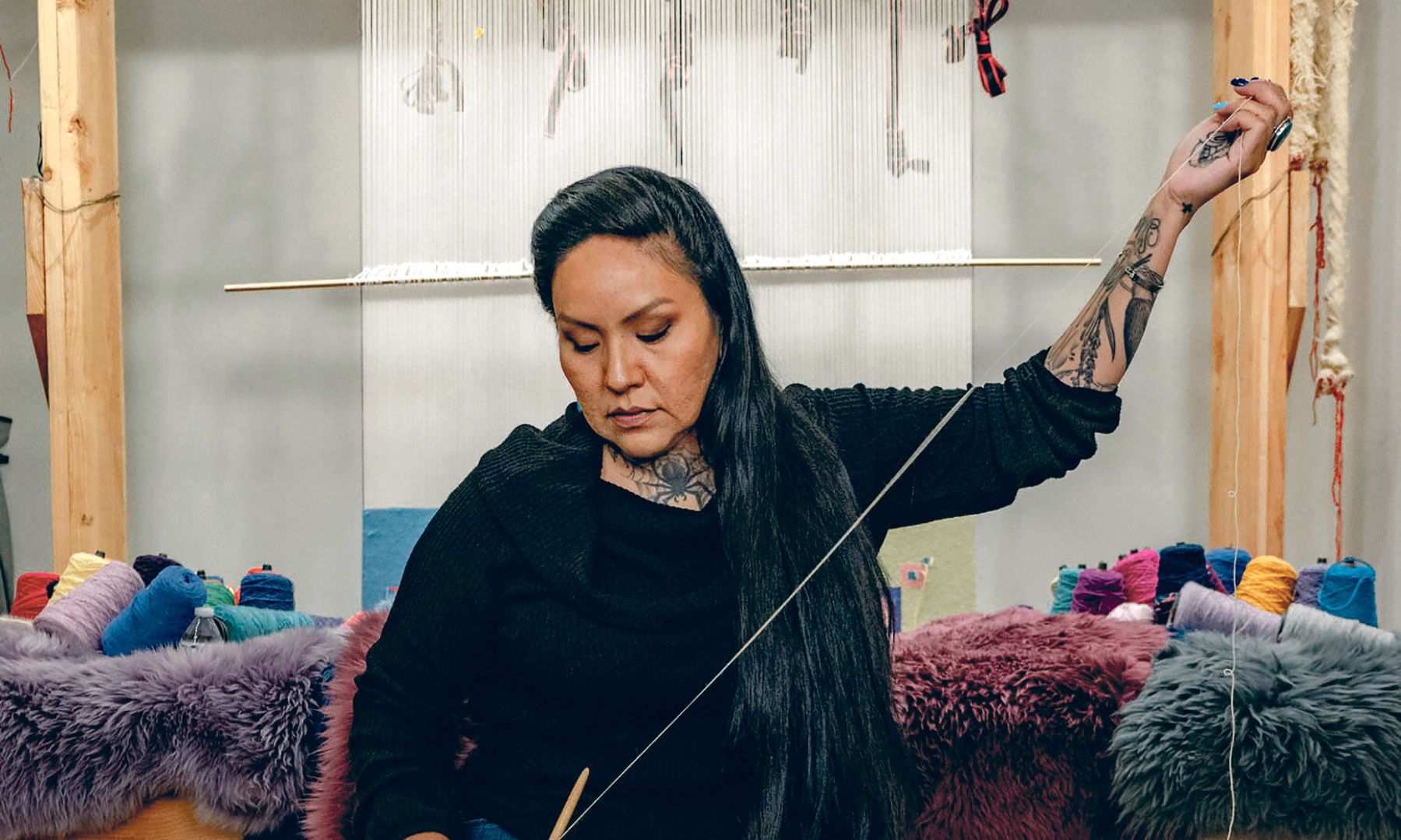A stitch in time: Melissa Cody’s practice is rooted in the Germantown Revival style, originating in the practice of using the fibres in commercially dyed government-issue blankets Courtesy Graham Nystrom
Webbed Skies at MoMA PS1 is the first major museum exhibition for Melissa Cody. Cody is a fourth-generation Navajo/Diné weaver, and much of her practice is rooted in the Germantown Revival style: a type of Navajo weaving developed when weavers began to take apart the commercially dyed blankets provided to them by the US government, repurposing the fibres to create tapestries rooted in their own traditions. This style is also indicative of Cody’s work in its harmonious blend of generational practices. While her work is no doubt an offspring of ancestral tradition, it is also a bridge towards a new generation of weavers and artists, as well as towards a large, international audience.
Melissa Cody’s exhibition at MoMA PS1—her first major museum show—includes Carbidopa-Levodopa Release (2009) Courtesy the artist and Garth Greenan Gallery
The Art Newspaper: There are so many different layers of yourself that coincide in your work. There is Navajo tradition but also visual influences from your childhood, narratives around personal life events and more.
Melissa Cody: I started weaving when I was five years old. I can look back at every piece that I’ve woven, and they all have their own time stamps of where I was at that time in my life, so it’s very biographical in that sense. It has also been a personal journey of understanding my own artistic practice and critiquing it in order to develop larger bodies of work that exist around cohesive themes or explore the events of my life. I credit a lot of that to having a really introspective perspective instilled in me at a young age by my mother, who pushed me to think critically about the work and to have a perspective with each textile. Then, as I grew into going to college and studying art, I began considering my textiles from a viewer’s perspective or with a wider audience in mind.
Growing up in the 1980s and 1990s, a lot of the textiles of that era were revolving around what was considered tradition, though at one point in our tribal history, a lot of those designs had actually been introduced by third parties or outside influences (whether it was trading posts, railroads, art galleries or other influences from off the reservation), so I was trying to see where the new traditions would take my generation. Early on, I was influenced by the 8-bit video games of my childhood; the way that I look at my loom and plan out my patterning is a similar aesthetic in terms of thinking in square pixels, and how the math and geometry of those types of games and the layout of the screen might translate into what I do on the loom.
You also made a body of work around your father’s Parkinson’s diagnosis at one point.
In 2012, when my father was moving along with that diagnosis and I was processing this major event in my family’s life, working on the loom became a therapeutic process. That was a turning point where I began shifting away from weaving textiles that were more traditional and moving into work that was speaking to personal narratives. I think this shift was really important for younger weavers who were looking at my work as moving the tradition forward, and it made it OK to deviate from cookie-cutter patterns and into work that was speaking to personal testament rather than solely aesthetics and design value. I have a three-year-old daughter and a nine-month-old son, so I think becoming a parent has also made me hyper-aware of where the weaving tradition will go in the future.
The geometry of the 8-bit video games of the 1980s and 1990s has helped to inform works such as Under Cover of Webbed Skies (2021) Courtesy the artist and Garth Greenan Gallery
How long might it take you to complete a piece?
It varies by size. For large-scale work, I have three 10ft-tall looms in my studio that are 8ft to 10ft wide, and I’m working on 9ft pieces that take on average about six months. Right now I’m weaving six days a week, eight to nine hours a day, but sometimes if I’m really involved in a piece I can go longer. Physically, it’s very taxing on the body, but when you get your stamina going you can really be involved in the piece, especially if the design is constantly shifting and changing.
Growing up, the elders always told us: “Don’t be away from your loom for too long.” In a technical way, you’re working with this wool where the fibres are constantly stretching, so they’re thinking of the weaving’s structural integrity, but they’re also warning you not to be away for too long so you don’t forget where you are in your pattern and have to relearn where you’re at in order to get back into that groove.
It also feels like a metaphor: to keep close to your roots and stay grounded.
A lot of it goes back to that foundational respect, because it is a conversation you’re having with your loom. I’m giving my life in terms of time and energy and physical exertion into each textile, but it’s a back
and forth, where it’s breathing life into me and fulfilling different aspects of my culture and my connection to the generations before me. It’s very much reciprocal.
• Melissa Cody: Webbed Skies, until 9 September, MoMA PS1, Queens, New York

